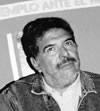
Pablo Emilio Escobar Gaviria was a Colombian drug lord, narcoterrorist, and politician who was the founder and sole leader of the Medellín Cartel. Dubbed "the king of cocaine", Escobar was one of the wealthiest criminals in history, having amassed an estimated net worth of US$30 billion by the time of his death—equivalent to $70 billion as of 2022—while his drug cartel monopolized the cocaine trade into the United States in the 1980s and early 1990s.
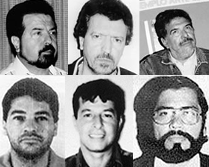
The Cali Cartel was a drug cartel based in southern Colombia, around the city of Cali and the Valle del Cauca. Its founders were the brothers Gilberto Rodríguez Orejuela, Miguel Rodríguez Orejuela and José Santacruz Londoño. They broke away from Pablo Escobar and his Medellín associates in 1988, when Hélmer "Pacho" Herrera joined what became a four-man executive board that ran the cartel.
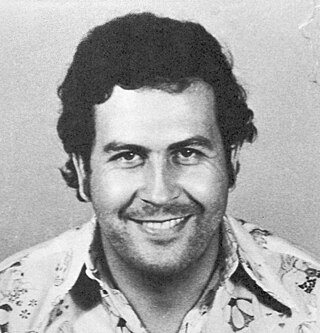
The Medellín Cartel was a powerful and highly organized Colombian drug cartel and terrorist organization originating in the city of Medellín, Colombia, that was founded and led by Pablo Escobar. It is often considered to be the first major "drug cartel" and was referred to as such due to the organization's upper echelons and overall power-structure being built on a partnership between multiple Colombian traffickers operating alongside Escobar. Other members included Jorge Luis Ochoa Vásquez, Fabio Ochoa Vásquez, Juan David Ochoa Vásquez, José Gonzalo Rodríguez Gacha, and Carlos Lehder. Escobar's main partner in the organization was his cousin Gustavo Gaviria, who handled much of the cartel's shipping arrangements and the more general and detailed logistical aspects of the cocaine trafficking routes and international smuggling networks, which were supplying at least 80% of the world's cocaine during its peak.

Carlos Enrique Lehder Rivas is a Colombian and German former drug lord who was co-founder of the Medellín Cartel. Born to a German father and Colombian mother, he was the first high-level drug trafficker extradited to the United States, after which he was released from prison in the United States after 33 years in 2020. Originally from Armenia, Colombia, Lehder eventually ran a cocaine transport empire on Norman's Cay island, 210 miles (340 km) off the Florida coast in the central Bahamas.
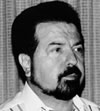
Gilberto José Rodríguez Orejuela was a Colombian drug lord and one of the leaders of the Cali Cartel. Orejuela formed the cartel with his brother, Miguel Rodríguez Orejuela, José Santacruz Londoño, and Hélmer Herrera. The cartel emerged to prominence in the early 1990s, and was estimated to control about 80% of the American and 90% of the European cocaine markets in the mid-1990s. Rodríguez Orejuela was captured after a 1995 police campaign by Colombian authorities and sentenced to 15 years in prison. He obtained early release in 2002, and was re-arrested in 2003, after which he was extradited to the United States. There, he was sentenced to 30 years in prison, where he died in 2022.

José Santacruz Londoño was a Colombian drug lord. Along with Gilberto Rodríguez Orejuela, Miguel Rodríguez Orejuela, and Hélmer Herrera Buitrago, Londoño was a leader of the Cali Cartel.

Griselda Blanco Restrepo was a Colombian drug lord who was prominent in the cocaine-based drug trade and underworld of Miami, during the 1970s through the early 2000s, and who has also been claimed by some to have been part of the Medellín Cartel. She was shot dead in Medellín on September 3, 2012 at the age of 69.

Miguel Ángel Rodríguez Orejuela is a convicted Colombian drug lord, formerly one of the leaders of the Cali Cartel, based in the city of Cali. He is the younger brother of Gilberto Rodríguez Orejuela. He married Miss Colombia 1974, Martha Lucía Echeverry.

José Gonzalo Rodríguez Alvarez Gacha, also known by the nicknames Don Sombrero and El Mexicano, was a Colombian drug lord who was one of the leaders of the Medellín Cartel along with the Ochoa brothers and Pablo Escobar. At the height of his criminal career, Rodríguez was acknowledged as one of the world's most successful drug dealers. In 1988, Forbes magazine included him in their annual list of the world's billionaires.
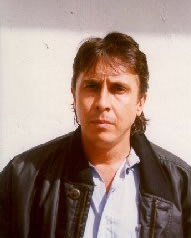
Fabio Ochoa Vásquez is a former leading member of the Medellín Cartel, along with his older brothers Juan David and Jorge Luis. His role briefly made him a billionaire. He was extradited to the US and served 25 years of a 30-year sentence in federal prison. He was released from prison in December 2024, and returned to Colombia.

Jorge Luis Ochoa Vásquez is a Colombian former drug trafficker who was one of the founding members of the Medellín Cartel in the late 1970s. The cartel's key members were Pablo Escobar, Carlos Lehder, José Gonzalo Rodríguez Gacha, Gustavo Gaviria, Jorge Ochoa, and his brothers Juan David and Fabio.

Francisco Hélmer Herrera Buitrago, also known as "Pacho" and "H7", was a Colombian drug trafficker, fourth in command in the Cali Cartel, and believed to be the son of Benjamín Herrera Zuleta.

The illegal drug trade in Colombia has, since the 1970s, centered successively on four major drug trafficking cartels: Medellín, Cali, Norte del Valle, and North Coast, as well as several bandas criminales, or BACRIMs. The trade eventually created a new social class and influenced several aspects of Colombian culture, economics, and politics.
A drug lord, drug baron, kingpin, or lord of drugs is a type of crime boss in charge of a drug trafficking network, organization, or enterprise.

Narcos is an American crime drama television series created and produced by Chris Brancato, Carlo Bernard, and Doug Miro. Set and filmed in Colombia, seasons 1 and 2 are based on the story of Colombian narcoterrorist and drug lord Pablo Escobar, leader of the Medellín Cartel and billionaire through the production and distribution of cocaine. The series also focuses on Escobar's interactions with drug lords, Drug Enforcement Administration (DEA) agents, and various opposition entities. Season 3 picks up after the fall of Escobar and continues to follow the DEA as they try to shut down the rise of the infamous Cali Cartel.

The third and final season of Narcos, an American crime thriller drama streaming television series produced and created by Chris Brancato, Carlo Bernard, and Doug Miro, follows the story of the Cali Cartel. Pedro Pascal reprises his role from the previous two seasons.

The cocaine boom was a stark increase in the illegal production and trade of the drug cocaine that first began in the mid to late 1970s before then peaking during the 1980s. The boom was the result of organized smugglers who imported cocaine from Latin America to the United States, and a rising demand in cocaine due to cultural trends in the United States. Smuggling rings of Cuban exiles organized trade networks from Latin America to Miami that streamlined the import of cocaine to the United States. Americans also began favoring less of the drugs popular in the 60s counterculture such as marijuana and LSD, and instead began to prefer cocaine due to a mystique of prestige that was developing around it. This increase in cocaine trade fueled the rise of the crack epidemic and government sponsored anti-drug campaigns.
José Orlando Henao Montoya, also known by the nicknames 'Don H' and El Hombre del Overol, was a Colombian drug lord who was one of the leaders of the notorious Norte del Valle Cartel along with his brothers and associates like Iván Urdinola Grajales. During his career he was considered an extremely cunning criminal and in the words of his former associates the Rodriguez Orejuela brothers "More bloodthirsty than Pablo Escobar".
Rafael Cardona Salazar, also known as Rafa Salazar, was a Colombian drug dealer who shipped cocaine into the United States through Miami, Florida. He first worked with the Medellín Cartel, potentially heading their operations in the United States, and then at some point switched allegiance to the Cali Cartel. Miami police said Salazar was responsible for 80% of the cocaine being shipped into the U.S. In 1986, Salazar was indicted by a U.S. federal grand jury for conspiracy resulting in the 1986 murder of Barry Seal, a former Medellín dealer turned informant. He was murdered by unknown gunmen in Medellín in 1987.


